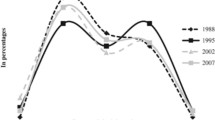Abstract
This article builds and estimates several econometric models that explain and forecast the outcomes of the French elections for the European Parliament. These models show the influence of the change in the local unemployment rate to explain the vote for the moderate Left and the moderate Right in the French elections for the European Parliament. These models appear to be accurate in forecasting the elections of the past, and their behavior for the 2009 French election for the European Parliament is satisfactory.
Similar content being viewed by others
References
Abramowitz, A. I. (2008). It’s about time: forecasting the 2008 presidential election with the time-for-change model. International Journal of Forecasting, 24, 209–217.
Auberger, A. (2005). Forecasts of the 2004 French European election. Swiss Political Science Review, 11, 61–78.
Auberger, A. (2010). Popularity and vote: forecasting the 2007 French presidential election. Canadian Journal of Political Science, 43, 123–136.
Auberger, A., & Dubois, E. (2005). The influence of local and national economic conditions on French legislative elections. Public Choice, 125, 363–383.
Dubois, E. (2002). Un modèle de prévision par département pour les élections présidentielles françaises. Working Paper. University of Paris I, LAEP.
Fair, R. C. (1978). The effect of economic events on votes for president. The Review of Economics and Statistics, 60, 159–173.
Fair, R. C. (1996). Econometrics and presidential elections. Journal of Economic Perspectives, 10, 89–102.
Fauvelle-Aymar, C., Lafay, J. D., & Servais, M. (2000). The impact of turnout on electoral choices: an econometric analysis of the French case. Electoral Studies, 19, 393–412.
Hausman, J. A. (1978). Specification tests in econometrics. Econometrica, 46, 1251–1271.
Hibbs, D. A., Jr. (1977). Political parties and macroeconomic policies and outcomes in the United States. American Political Science Review, 71, 1467–1487.
Hsiao, C. (2003). Analysis of panel data (2nd ed.). Cambridge: Cambridge University Press.
Jérôme, B., Jérôme-Speziari, V., & Lewis-Beck, M. S. (2003). Reordering the French election calendar: forecasting the consequences for 2002. European Journal of Political Research, 42, 425–440.
Key, V. O., Jr. (1966). The responsible electorate. Cambridge: Harvard University Press.
Kramer, G. H. (1971). Short-term fluctuations in U.S. voting behavior, 1896–1964. American Political Science Review, 65, 131–143.
Lewis-Beck, M. S. (1997). Who’s the chef? Economic voting under a dual executive. European Journal of Political Research, 31, 315–325.
Lewis-Beck, M. S., & Nadeau, R. (2000). French electoral institutions and the economic vote. Electoral Studies, 19, 171–182.
Lewis-Beck, M., Nadeau, R., & Bélanger, E. (2004). General election forecasts in the United Kingdom: a political economy model. Electoral Studies, 23, 279–290.
Madsen, H. (1980). Electoral outcomes and macro-economic policies: the Scandinavian cases. In P. Whiteley (Ed.), Models of political economy (pp. 15–46). London: Sage.
Marsh, M. (1998). Testing the second-order election model after four European elections. British Journal of Political Science, 28, 591–607.
Mueller, D. (2003). Public choice III. Cambridge: Cambridge University Press.
Paldam, M. (1981). A preliminary survey of the theories and findings on vote and popularity functions. European Journal of Political Research, 9, 181–199.
Reif, K., & Schmitt, H. (1980). Nine second order national elections: a conceptual framework for the analysis of European election results. European Journal of Political Research, 8, 3–44.
Stigler, G. J. (1973). Short-term fluctuations in U.S. voting behavior, 1896–1964. American Economic Review, 63, 131–143.
Wooldridge, J. M. (2002). Econometric analysis of cross section and panel data. Cambridge: MIT Press.
Author information
Authors and Affiliations
Corresponding author
Rights and permissions
About this article
Cite this article
Auberger, A. Voting and economic factors in French elections for the European Parliament. Public Choice 153, 329–340 (2012). https://doi.org/10.1007/s11127-011-9796-9
Received:
Accepted:
Published:
Issue Date:
DOI: https://doi.org/10.1007/s11127-011-9796-9




